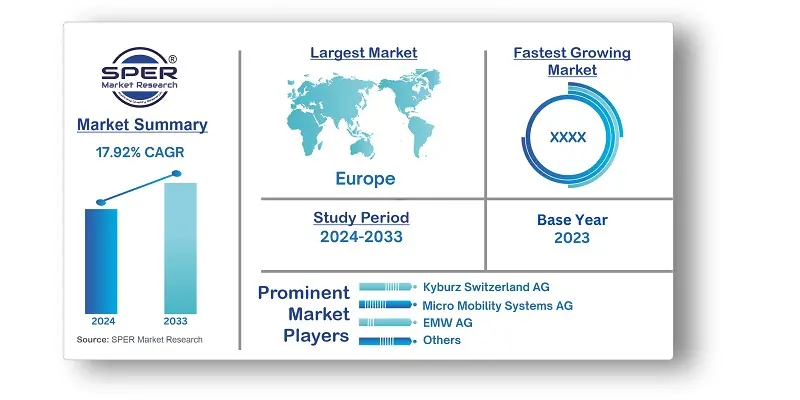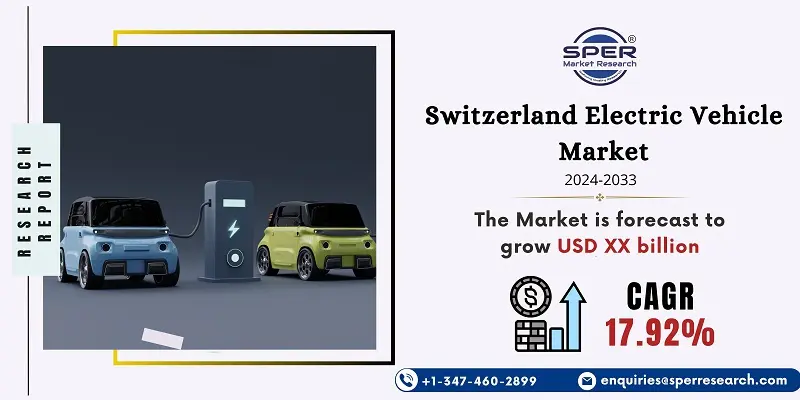
Switzerland Electric Vehicle Market Growth, Size, Trends, Share, Demand and Future Outlook
Switzerland Electric Vehicle Market Size- By Component, By Propulsion Type, By Vehicle Type- Regional Outlook, Competitive Strategies and Segment Forecast to 2033
| Published: Jul-2024 | Report ID: AMIN24159 | Pages: 1 - 109 | Formats*: |
| Category : Automotive & Transportation | |||
- BYD, the world's top producer of energy cars and batteries, and the Emil Frey Group reached an agreement in February 2024 to distribute and market BYD's line of cutting-edge electric vehicles in Switzerland and Liechtenstein. Emil Frey and BYD are marking an important milestone with our relationship. It signals the start of a new chapter in the automotive history of Liechtenstein and Switzerland: the era of state-of-the-art electric automobiles.
- In August 2023, Energy Infrastructure Partners, a prominent energy transition investor, inked a partnership deal with Electra, an early adopter and European champion in the electric vehicle infrastructure sector, on behalf of a consortium of Swiss pension funds.


| Report Metric | Details |
| Market size available for years | 2020-2033 |
| Base year considered | 2023 |
| Forecast period | 2024-2033 |
| Segments covered | By Component, By Propulsion Type, By Vehicle Type |
| Regions covered | Eastern Region, Western Region, Southern Region, Northern Region |
| Companies Covered | Kyburz Switzerland AG, Micro Mobility Systems AG, EMW AG, eROCKIT Systems GmbH, Qooder, Others. |
- Urban Commuters
- Environmental Advocates
- Tech Enthusiasts
- Corporate Fleets
- Government Entities
| By Component: |
|
| By Propulsion Type: |
|
| By Vehicle Type: |
|
- Switzerland Electric Vehicle Market Size (FY’2024-FY’2033)
- Overview of Switzerland Electric Vehicle Market
- Segmentation of Switzerland Electric Vehicle Market By Component (Battery Cells and Packs, Fuel Stack, On-Board Charger, Electric Motor, Brake, Wheel and Suspension, Body and Chassis, Others)
- Segmentation of Switzerland Electric Vehicle Market By Propulsion Type {(Batter Electric Vehicle (BEV), Fuel Cell Electric Vehicle (FCEV), Plug-In Hybrid Electric Vehicle (PHE)}
- Segmentation of Switzerland Electric Vehicle Market By Vehicle Type (Passenger Vehicles, Commercial Vehicles, Others)
- Expansion Analysis of Switzerland Electric Vehicle Market
- Problems and Obstacles in Switzerland Electric Vehicle Market
- Competitive Landscape in the Switzerland Electric Vehicle Market
- Impact of COVID-19 and Demonetization on Switzerland Electric Vehicle Market
- Details on Current Investment in Switzerland Electric Vehicle Market
- Competitive Analysis of Switzerland Electric Vehicle Market
- Prominent Players in the Switzerland Electric Vehicle Market
- SWOT Analysis of Switzerland Electric Vehicle Market
- Switzerland Electric Vehicle Market Future Outlook and Projections (FY’2024-FY’2033)
- Recommendations from Analyst
1.1. Scope of the report1.2. Market segment analysis
2.1. Research data source
2.1.1. Secondary Data2.1.2. Primary Data2.1.3. SPER’s internal database2.1.4. Premium insight from KOL’s
2.2. Market size estimation
2.2.1. Top-down and Bottom-up approach
2.3. Data triangulation
4.1. Driver, Restraint, Opportunity and Challenges analysis
4.1.1. Drivers4.1.2. Restraints4.1.3. Opportunities4.1.4. Challenges
4.2. COVID-19 Impacts of the Switzerland Electric Vehicle Market
5.1. SWOT Analysis
5.1.1. Strengths5.1.2. Weaknesses5.1.3. Opportunities5.1.4. Threats
5.2. PESTEL Analysis
5.2.1. Political Landscape5.2.2. Economic Landscape5.2.3. Social Landscape5.2.4. Technological Landscape5.2.5. Environmental Landscape5.2.6. Legal Landscape
5.3. PORTER’s Five Forces
5.3.1. Bargaining power of suppliers5.3.2. Bargaining power of buyers5.3.3. Threat of Substitute5.3.4. Threat of new entrant5.3.5. Competitive rivalry
5.4. Heat Map Analysis
6.1. Switzerland Electric Vehicle Market Manufacturing Base Distribution, Sales Area, Product Type6.2. Mergers & Acquisitions, Partnerships, Product Launch, and Collaboration in Switzerland Electric Vehicle Market
7.1. Switzerland Electric Vehicle Market Size, Share and Forecast, By Component, 2020-20267.2. Switzerland Electric Vehicle Market Size, Share and Forecast, By Component, 2027-20337.3. Battery Cells and Packs7.4. Fuel Stack7.5. On-Board Charger7.6. Electric Motor7.7. Brake, Wheel and Suspension7.8. Body and Chassis7.9. Others
8.1. Switzerland Electric Vehicle Market Size, Share and Forecast, By Propulsion Type, 2020-20268.2. Switzerland Electric Vehicle Market Size, Share and Forecast, By Propulsion Type, 2027-20338.3. Battery Electric Vehicle (BEV)8.4. Fuel Cell Electric Vehicle (FCEV)8.5. Plug-In Hybrid Electric Vehicle (PHEV)
9.1. Switzerland Electric Vehicle Market Size, Share and Forecast, By Vehicle Type, 2020-20269.2. Switzerland Electric Vehicle Market Size, Share and Forecast, By Vehicle Type, 2027-20339.3. Passenger Vehicles9.4. Commercial Vehicles9.5. Others
10.1. Switzerland Electric Vehicle Market Size and Market Share
11.1. Switzerland Electric Vehicle Market Size and Market Share By Region (2020-2026)11.2. Switzerland Electric Vehicle Market Size and Market Share By Region (2027-2033)11.3. Eastern Region11.4. Western Region11.5. Southern Region11.6. Northern Region
12.1. Kyburz Switzerland AG:
12.1.1. Company details12.1.2. Financial outlook12.1.3. Product summary12.1.4. Recent developments
12.2. Micro Mobility Systems AG
12.2.1. Company details12.2.2. Financial outlook12.2.3. Product summary12.2.4. Recent developments
12.3. EMW AG
12.3.1. Company details12.3.2. Financial outlook12.3.3. Product summary12.3.4. Recent developments
12.4. eROCKIT Systems GmbH
12.4.1. Company details12.4.2. Financial outlook12.4.3. Product summary12.4.4. Recent developments
12.5. Qooder
12.5.1. Company details12.5.2. Financial outlook12.5.3. Product summary12.5.4. Recent developments
12.6. Others
SPER Market Research’s methodology uses great emphasis on primary research to ensure that the market intelligence insights are up to date, reliable and accurate. Primary interviews are done with players involved in each phase of a supply chain to analyze the market forecasting. The secondary research method is used to help you fully understand how the future markets and the spending patterns look likes.
The report is based on in-depth qualitative and quantitative analysis of the Product Market. The quantitative analysis involves the application of various projection and sampling techniques. The qualitative analysis involves primary interviews, surveys, and vendor briefings. The data gathered as a result of these processes are validated through experts opinion. Our research methodology entails an ideal mixture of primary and secondary initiatives.



Frequently Asked Questions About This Report
PLACE AN ORDER
Year End Discount
Sample Report
Pre-Purchase Inquiry
NEED CUSTOMIZATION?
Request CustomizationCALL OR EMAIL US
100% Secure Payment






Related Reports
Our Global Clients
Our data-driven insights have influenced the strategy of 200+ reputed companies across the globe.




















